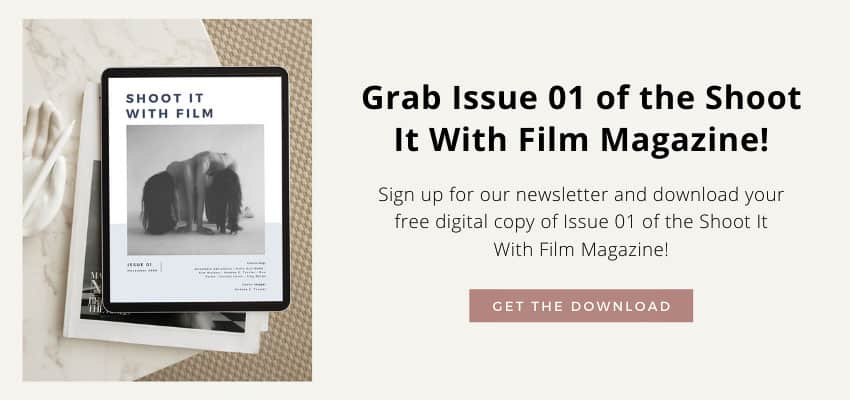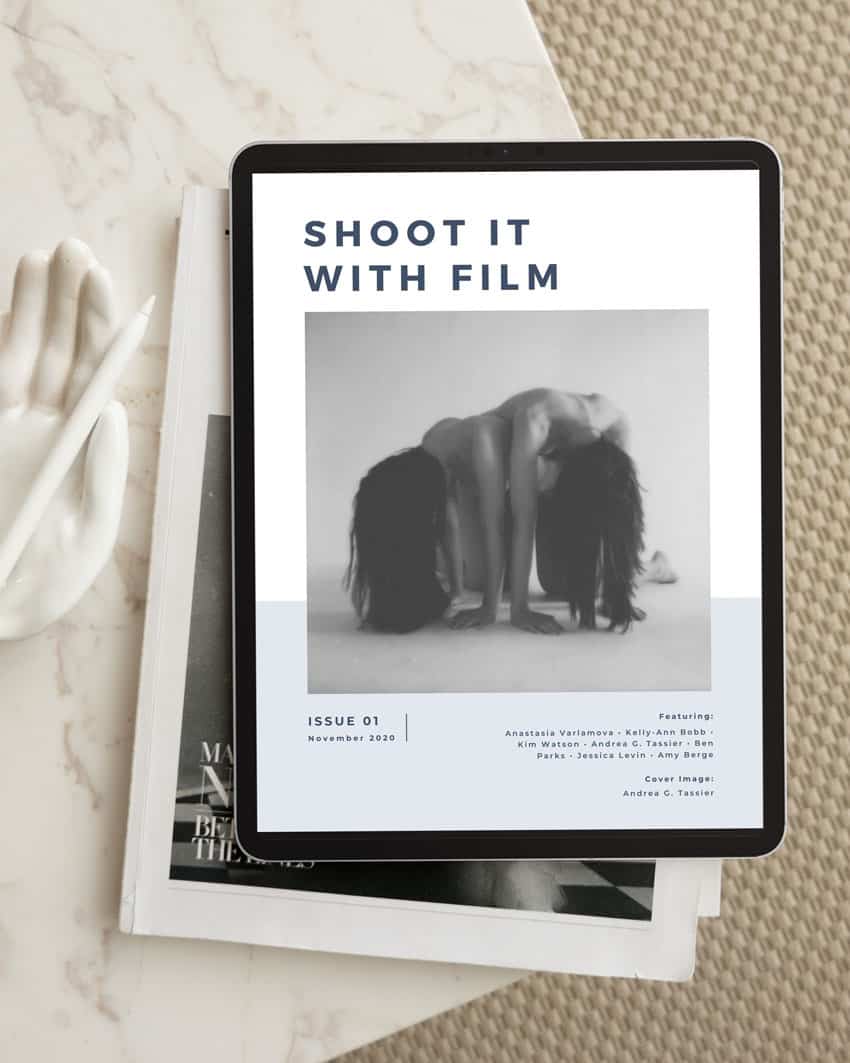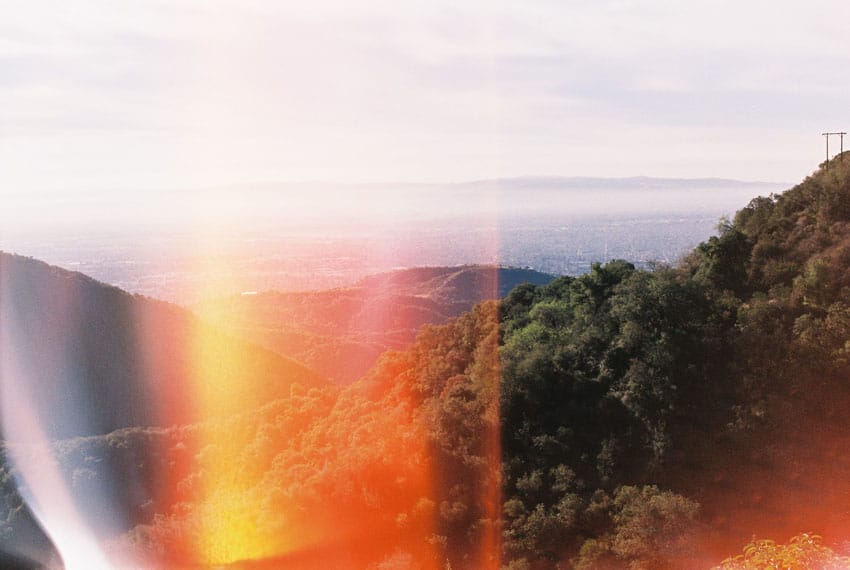
Written by Katya Rowny
There is nothing like coming across an old film camera in your forgotten collection only to realize you have undeveloped film still in the camera.
Recently, as I was digging in my collection of disregarded cameras, I came across a Canon T50 (find on eBay) that I bought 4-5 years ago with half a roll shot on it.
This is such a delight, finding old film and not remembering what’s on it! I finished shooting the roll and when I developed it, I found some great memories.
I couldn’t help but think how treasures like this are impossible with digital cameras, and how much I enjoy film for the unexpected nature of it.
If you’re just starting to fall in love with film photography, or hoping to rekindle that affection, these five tips should help get you on the right track.

1. Start With a Point-and-Shoot Film Camera
Starting off, an important decision to make is which film camera to choose. Depending on your style and comfort level with photography, I suggest getting a point-and-shoot, and then moving on to a 35mm SLR or even a rangefinder.
When I started shooting film four years ago, I bought different point-and-shoots from eBay, hoping to rekindle my love of photography. Thankfully, most, if not all, of the cameras I acquired worked well, only needing different types of batteries.
Shooting with these cameras reignited my passion for shooting film, and, as they say, the rest is history!
Point-and-shoot film cameras are easy to use, often just needing a battery to operate. Sometimes the battery contacts will need to be cleaned, but that’s an easy repair.
Here’s a list of some of the best point-and-shoot film cameras.


I recommend buying your first camera from a reputable source such as KEH Camera, as they test all of their cameras before selling.
Depending on where you live, there might also be a local camera shop that sells used gear. A local photography nonprofit, Tacoma Photo Center, opened a camera library that people in the community can utilize. They have a selection of different styles and types of cameras that have been generously donated.
This is a great way to test out different cameras without committing to one that you may later not enjoy. If you have a local camera shop near you, you could always work with the owners to implement something similar.
For more tips on buying your first film camera, check out this article.

One of my very first cameras I bought was back in 2017, a Canon AE-1 Program. It came with some different lenses to try and a release cable and flash. I was so stoked to shoot it, but only ended up putting a few rolls through it, paralyzed by not understanding all of its features.
More recently, I tried again, only to get my scans back and realizing it had terrible light leaks. Unfortunately, this camera is sitting in a bin, disassembled, still waiting for new light seals. If I’d come to this camera later in my journey when I was more comfortable shooting film, it would have been a totally different story.

Another camera I received early on in my journey was a Yashica D. I was gifted this camera from a family friend who graciously sent me film as well.
To say that I was overwhelmed was an understatement; I knew nothing about medium format or TLR cameras. In the beginning, I fumbled my way through, learning as I went, but it was a slow uphill battle, and, oftentimes, I felt discouraged, wanting to give up.
While I’m grateful for those cameras, the learning curve set me back several months. I wish I could go back in time and give 2017 me a point-and-shoot to rekindle that love of photography!
By trying to use a camera I was unfamiliar with, my adventures in film photography stalled. This is why It’s important to start with a camera that you feel comfortable with and can grow with.

2. Use Fresh Film
My next bit of advice is to use fresh film!
This may seem like a no-brainer, but when I first began, I bought expired film because it was cheap and plentiful. (Thanks, eBay!) Most of the film I bought was probably not cold stored properly, hence why the scans came back degraded and dull.
I also made the mistake of shooting expired film in the point-and-shoots I had already acquired, meaning I could not change the ISO, which affected the film results greatly.
Again, I found myself disappointed and wondering why I wanted to shoot. Fresh film would have saved me that heartache.


3. Stick to One Film Stock
My next tidbit is to use one film stock for three to four months to understand how it reacts to different lighting situations.
Depending on the seasons where you live, the light can drastically change within an hour, meaning the photography results will vary.
I ended up buying a variety of different films, and, as time progressed, I could not tell you which film stock was what, which meant that I didn’t know which one I favored more or less.
This can be quite frustrating, especially when a film is on sale and you want to stock up but can’t because you’re unsure if this is the film you enjoyed or not.
As the years have progressed and I have continued to shoot film, I’ve realized that I love Kodak Portra film stocks. I wish I’d been more systematic about it, because I’ve missed several sales of this expensive film.
For a guide to different color films, check out this article, and here is a good overview of Ilford black and white film stocks.


4. Choose a Film Lab that Fits Your Needs
Another important consideration is your film lab. There are numerous ones throughout the United States where you can mail your film to them no matter where you live. Some of the more popular ones are The Darkroom in California, theFINDlab in Utah, Indie Film Lab in Alabama, and Northeast Photographic in Maine. Here is an article comparing some of the more prominent ones.
When choosing a film lab, check prices, comparing 35mm and 120. Prices tend to differ between color and b&w. Most labs offer different tier scans ranging from basic to premium.
Also, I recommend getting your negatives mailed back to you so that you can rescan at a later date if need be. Depending on the lab, they will send your negatives back to you for a fee (usually around $10), destroy them, or some even offer a cloud service where your scans will be stored for a limited amount of time.
This is how I discovered my very first film scans from four years ago from The Darkroom in California. The Darkroom Film Ordering System (FOS) stores each photo album online for 60 days for free as part of your order. The 60 days is valid from the date the photos were uploaded. Storage beyond 60 days requires a subscription, costing $18 a year, and if the album is expired a subscription will reactivate it within 24 hours.
It’s worth it to do the research to figure out which film lab provides what you will personally use.


5. Find a Local Photography Club
Last but not least, I recommend finding a local photography club.
Moving to the Pacific Northwest, I discovered two amazing analog communities within an hour of where I live. I found both of these photography clubs through Instagram.
Also, by attending a local photography sale that is hosted by the Puget Sound Photographic Society twice a year, I’ve connected with local film labs and other niche groups, such as a pinhole camera club.
Sometimes you are able to connect with people just by being out and about with your film camera and striking up a conversation. I feel very fortunate to have such an active group with people who are willing to help and host events in the community. Both of these groups have a Discord server where people host meetups, sell their gear, ask questions, and tell others about other local events.
Through my connections, I was able to attend my first event recently and sold prints for the first time. I met other like minded folks and was able to buy a lens for a Soviet camera I had been hunting for.
It has been so fun to meet other people who love film photography like you do and to explore new places together.

Image Credit: Drew Lindgren
Final Thoughts
With these tips in mind, you’ll be shooting a stress-free roll of film in no time!
If you are looking for online help, check out our website, Shoot It With Film, where it’s jam-packed with all kinds of resources!
Don’t be afraid to ask for help and guidance on this journey, most people love helping others who shoot film!
Most importantly, don’t be afraid to try, try and mess up, make mistakes, but learn and grow along the way!


Thank you so much, Katya! Katya is a regular contributor for Shoot It With Film, and you can check out her other articles here, such as the Olympus XA2 Point & Shoot Film Camera Review and Elektra 100 Film Stock Review.
You can also find more of Katya’s work on her website and Instagram.
Leave your questions about shooting film below in the comments!








Blog Comments
Carla
December 22, 2023 at 10:49 am
I’d also like to plug Fromex Photo in CA, they’ve always given me great service and their prices are excellent.
Katya
December 23, 2023 at 2:26 pm
Hi Carla!
I’ve never heard of this lab, thanks for letting us know about it!
ed
December 22, 2023 at 11:11 am
I saw the first photo with the Seattle film works. That film had a remjet backing on It.,It would gunk up many photo lab machine because seattle film works never told anyone that you could not take it to any lab as far as I know they did not it had to be sent to their lab. I use expired film all the time. I am an artist and the reason I shoot film is the unpredictable interesting artsy looking photos. I am not necessarily looking for technically sound photos. And the light leaks in the first one was interesting to me. And to find out about a camera, as I do, is go on Youtube. You will find many tutorials to help you
Katya
December 23, 2023 at 2:29 pm
Hi Ed!
I’ve actually never shot the film in the photo. I read on their packaging to only send to their lab so I stuck it in my fridge until I figured out where to send it.
And yes, YouTube has some great tutorials on cameras!
Thanks for reading and commenting.